endorcement details : Vic Firth Sticks - 7A / Remo Drum Heads - Ambassador Coated / Zildjian - 22" / 20" Light Constantinople /
21" Avedis Sweet Ride / 20" Light Constantinople / 15" Constantinople Crash / 14" Constantinople Hi hats /
Gretsch 12/14/18 Octagonal Badge and 12/14/20 Round Badge
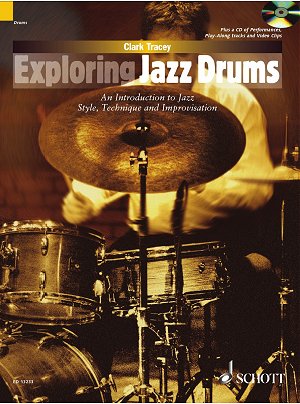 Clark's new drum manual 'Exploring Jazz Drums' published by Schott music is now available. It provides an intermediate level introduction to playing drum techniques including following scores, unusual time signatures, soloing, advice on equipment, as well as an entire chapter dedicated to playing with brushes.
Clark's new drum manual 'Exploring Jazz Drums' published by Schott music is now available. It provides an intermediate level introduction to playing drum techniques including following scores, unusual time signatures, soloing, advice on equipment, as well as an entire chapter dedicated to playing with brushes.It comes with a CD containing audio and video demonstrations, play-along tracks, and exercises performed by Clark with a live backing band. As always with a Schott publication it's superbly produced.
Exploring Jazz Drums is available from the Schott Music Shop for £16.99 (plus delivery). click here.
"Clark offers a unique insight into the various playing methods and techniques.. "
"there's also an excellent section on drum rudiments and how these can be extended creatively." "Excellent. "
Dave Gallant. Jazzwise. Feb 2013
Charles Wilcoxon - snare solo's
"One of the few books I strongly recommend all drummers to check out is Charles Wilcoxon's 'Modern Rudimental Swing Solos' which was written at the dawn of bebop around 1940. It gives invaluable methods of approaching the 27 original rudiments, followed by a series of snare solos. It has a military air to it generally but there are several dedications to jazz drummers. I've recorded the first 2 solos to give you some idea of how these pieces can help to develop a rolling snare technique. 'Rolling In Rhythm' (dedicated to Joe Morello) in particular opened doors for me in understanding Philly Joe Jones' style. 'Rhythmania' was dedicated to the President of NARD, Vincent L Mott. I hope you enjoy the pieces and urge you to track down that book!"
MIDI FILES
"The section below is intended as a drum workshop for intermediate players upwards and contains two rhythms that will stay up as regulars and one or two of my own personal
favourites. As a beginner you might like to keep the midi files or print this page.
Good luck and keep practising!"
Clark Tracey
The Midi examples below demonstrate how they would sound when played at an appropriate speed. These can be opened up in a midi sequencer and slowed down or looped for practise. For those not able to play midi files the clips are also reproduced as audio for Real Player.
The Flam
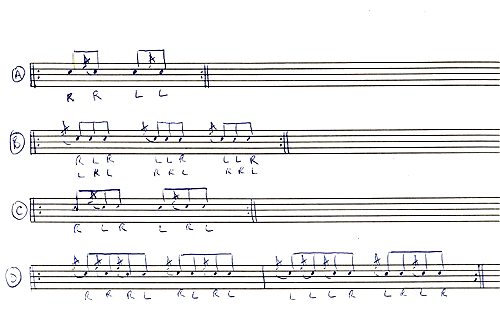
I love my dictionary interpretations but surely this can't apply to a drum rudiment: "An idle fancy; a falsehood; to deceive"! For beginner students who don't know this one or are unclear how to execute it, it is similar to a melodic 'grace note' when a single note is played in short anticipation of the main note. In other words, if you are playing a single beat in the right hand, the left hand plays a beat just before it. In practising this rudiment, it's a good idea to exaggerate the execution somewhat by playing the left hand from the wrist with little downward movement, followed by the main beat on the right hand which is played with a downward stroke from the elbow. When alternating flams from hand to hand, the left hand will raise high and the right remain near the drum following the first flam, and so on. I hope this makes sense! In exercise 2a of the paradiddle section, you will see a flam played at the beginning of each paradiddle. The first indicates the main beat as a right, the second will fall on the left hand as the main beat. Flams add a rich texture to a rhythmic pattern and I recommend adding one or two to a favourite phrase that you might use. Here are some exercises I'm sure you'll have fun with!
Snare/bass drum combinations
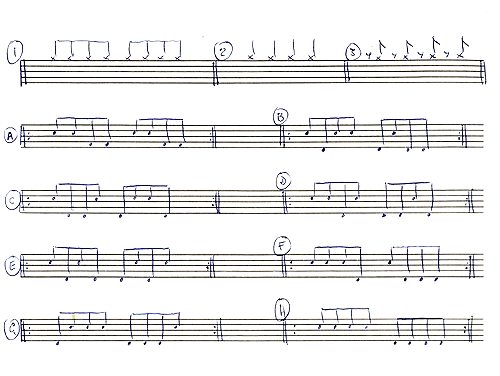
Here are some exercises I came up with for my students recently that offer permutations between snare and bass drum while keeping a steady beat on the hi hats. You should try playing each exercise at least 8 times comfortably before moving on to the next one. Begin with figure 1 on the hi hat and go through each exercise (A-H) then move on to figure 2 (A-H) and finally figure 3 (A-H). The snare is written high and the bass drum low.
Paradiddles
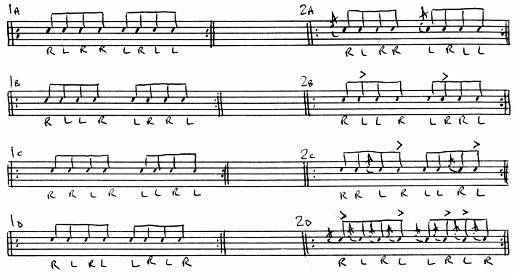
"A few words about our old favourite, the single paradiddle, inaccurately defined in my dictionary as: 'A drum roll in which the principal beats are struck by the left and right sticks in succession'. If only! I was taken aback recently when I asked a new student about the paradiddle. His response was that he'd 'tried that one'. What I've shown here are some examples of how we can vary practising this invaluable rudiment. During practise sessions, it's important to consider what variations you can apply to whichever rudiment or pattern you are working on. In its component form, the single paradiddle is the combination of the two most basic strokes available: a single stroke roll (R,L) and a double (R,R). By shifting the sticking one beat (figs. 1b-1d), we produce the 3 inverted paradiddles. If you've never tried these, you may be surprised at how much the movement of one beat can throw you initially! These inversions are interesting enough to work on, either individually or in their combinations. But we can take things a few steps further by adding a flam onto one of the beats (fig. 2a), or an accent (fig. 2b), a flam and accent (fig. 2c) or combinations of your own choosing (fig. 2d). Each variation has its own identity and you should find they will help to sharpen your concentration and your co-ordination. It's helpful to write the variations down in a sequence for your reference!"
Para diddle-diddle


"The lick of mine is basically a paradiddle-diddle spread over the drums using just the right hand and bass drum. More often than not, when I'm teaching somebody, I'm asked about how to use rudiments in a solo. I think at some point in our lives we've all questioned the relevance of endless attention to ratamacues, flam triplets and single drag paradiddles etc. etc. The important thing is to use one's imagination and after practising on the snare for precision and speed development, throw them around the drum set until you find something that makes sense and feels comfortable as I have done with this first example." ( Use the ' Key ' for example 1 & 2 )
Max Roach : mop mop

"The Max Roach "Mop Mop" ( or "For Big Sid" ) is a typically melodic pattern which Max uses to build a solo from. The phrase is played usually 4 times to begin, then into an open melodic improvisation, referring to the phrase occasionally and eventually finishing the solo with another 4 times. A great example of this is to be found on a double album under Max's name entitled "Again" recorded live in Paris."
Art Blakey : afro-lick
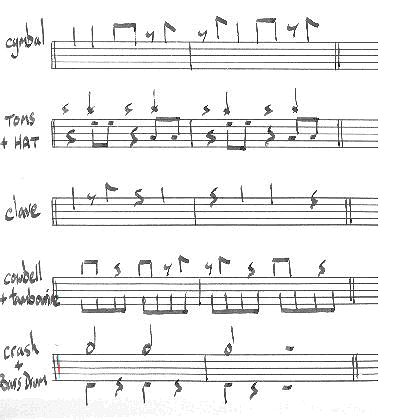
"The Art Blakey lick is one that I use when recreating one of his solos in my tribute band** and, as I'm often asked what it boils down to, here it is. The added percussion gives a tremendous lift to this afro-caribbean rhythm which Art employed for many years. Probably the most shining version of this one is from an album called "Live At Slugs" although I've seen it under other titles. The track is "New World" and as it's the only recorded version, shouldn't be too hard to find". (it is - webmaster)
